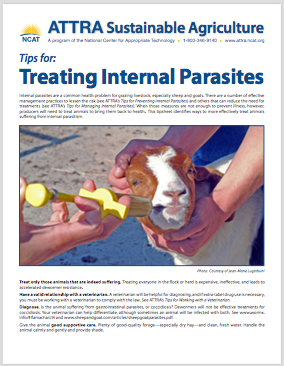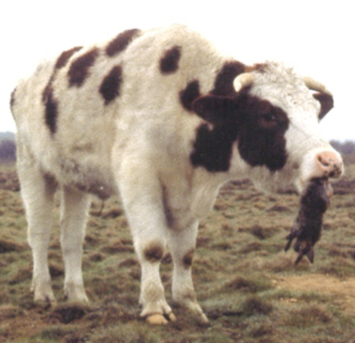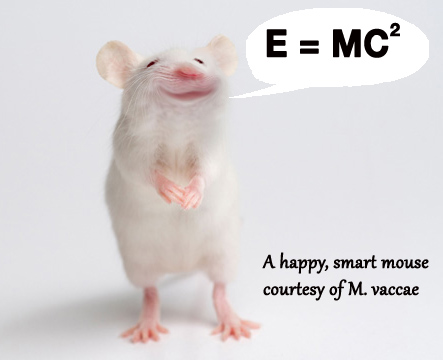
As a novice goatherd back in 1997, I was taught that every member of my research herd should be treated for internal parasites twice a year. Years later, I realize that was the wrong thing to do, and that doing “preventive” treatment like that was actually creating drug resistant parasites and increasing potential parasite problems in my herd. But what should we be doing instead? Here’s a summary for improved success from a series of publications from from ATTRA/NCAT. We’ve provided links to the publications so you can download them for further reading.
Treat only those animals that are suffering.
Treating only the animals that really need it reduces your costs and labor immediately. It also has long term benefits, as you’ll reduce how rapidly parasites become resistant to your dewormer. You can use FAMACHA to determine which animals need treatment for barberpole worms. (NCAT’s Dave Scott shows how in this video.)

Use the right dose.
Dewormer doses are weight based. Since most of us underestimate animal weights, we’re prone to under-dosing. For creating drug resistance, this can be as bad as treating every animal in the herd. It kills off the weakest parasites, leaving the strong to reproduce, so that the next time we deworm, we’ll be less successful.
If you don’t have time to weigh every animal, weigh the heaviest of those to be treated and give each animal that dose. If you’re dosing goats, remember that they need 1.5 to 2x the dose a sheep requires. (Your veterinarian can tell you which drugs require which dose.) By fasting your animals overnight you can increase medication effectiveness.
Maintain a parasite “refugia.”
Every time an animal is dewormed, all the susceptible parasites are killed. Those that survive reproduce, and over time you end up with an entire population of resistant parasites. By treating only animals that are suffering from parasites, and not those that are doing well in spite of a few parasites, you create a “refugia” or “refuge” of non-resistant parasites. Those parasites dilute the population of resistance, so when you do need to use a dewormer you will still have success.
Keep records.
Records of which animals require dosing and how much the dose was will help you make future management decisions, including culling. We’ll be covering culling for parasite resistance in a future article as well.
Adjust Your Management
Both the publication on “Managing Internal Parasites in Sheep and Goats,” and our first article in this series, “The Silver Bullet of Parasite Control in Small Ruminants,” provide suggestions for improved management that will decrease the risk that your stock will encounter larvae in pasture. They’re as simple as not grazing as short and setting up a rotational system so that when larvae hatch your stock are in a different paddock.
And what happened to my research goat herd? As the herd grew from 11 to 130, and my office work responsibilities increased, I just couldn’t keep up. Worming went by the wayside, and since I lived in an arid environment, and the research project required just the kind of rotational grazing used by many to keep livestock out of harms way, nothing bad happened. Goats stayed healthy, does bred back every season, and there was no evidence of parasites in the herd. It wasn’t until years later that I understood my luck. I hope all of you are just as lucky too!
Stay tuned! In future issues we’ll talk about culling as a tool to increase parasite resistance.





In my admittedly modest experience with goats I have reached the conclusion that the key to avoiding parasite problems is to keep their noses as far as possible from the ground. This means grazing high residual on grass, or better yet, browsing on brush and trees. Grazing guru Walt Davis advises that if you don’t have a problem with brush you probably shouldn’t be running goats. I think he’s right, both ecologically and economically.
elemental sulfur is natural and found in green grass. Feeding it to animals will take care of the internal and external parisits. You will not end up with any drug resistant parisites. It is nature way of taking car of a problem.
~~By fasting your animals overnight you can increase medication effectiveness.~~ Oh there ya go! In our reawakened era of holistic solutions fasting is going to be found a powerful assist to good health. Dry fasting and intermittent fasting are the top tools to slimming and even removing toxic situations in us farmers as well!
Hi Pat,
I had never heard of elemental sulfur being used for internal parasites in small ruminants before, so I checked in with Linda Coffey at ATTRA/NCAT. Linda and a group of veterinarians and experts in small ruminants were the ones who put together the publications on managing and treating parasites that we’ve been highlighting. They provided some insights and some concerns and I’ve summarized them here.
The published literature shows no evidence that elemental sulfur has been tested for use against internal parasites. A lime-sulfur dip is used against external parasites, but even so, the sulfur contained in green, growing grass is not sufficient to prevent external parasite infection so grazing it won’t prevent internal or external parasites. There are also potential problems with using too much elemental sulfur in an animal’s diet. Sulfur can tie up minerals in the animal’s system, causing other health problems. This could be what is behind a Montana ranch account from the 1800s showing sulfur use killed just about every ewe on the place. It also might explain why one of the group of experts Linda works with lost two 9-month old lambs by feeding hay that had been treated with elemental sulfur to prevent mice from chewing on the twines.
Everyone agreed that it would be nice if there was an easy solution to the problem of parasites, there just isn’t. That’s why we’re focusing on the integrated approaches described here.
If you have other information about elemental sulfur that we may not have taken into account, we would love to hear it.
Thanks!
Comments are closed.